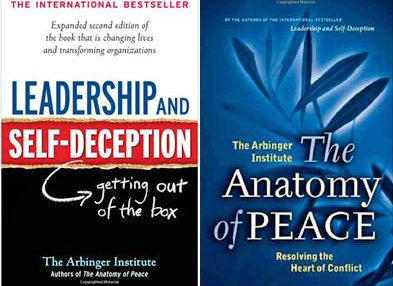Reading Room
 Welcome to my Reading Room!
Welcome to my Reading Room!
There is a great deal of information available in the agile community and beyond that address the values and principles importance to us. In these pages, I attempt to rein in these every growing resources to those that particularly speak to me, and hopefully to you. Here is an ever growing list of books I have found particularly useful and would recommend to you. Have a recommendation for me? Contact me, I'd love to hear about it.
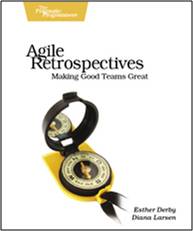 Are your retrospectives meaningful? Do your teams just go through the motions? Are you wondering if you should even do a retrospective at all? Then you need to read this book.
Are your retrospectives meaningful? Do your teams just go through the motions? Are you wondering if you should even do a retrospective at all? Then you need to read this book.
In Agile Retrospectives, Esther Derby and Diana Larsen compile a wealth of information about conducting retrospectives that lead your teams to continuous learning. Based on their years of experience the authors provide a six stage process to help ensure you can steer your team toward the path of improvement. Using the tips in this book will help Scrum Masters succeed at one of their greatest challenges.
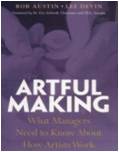 "A theatre company consistently delivers a valuable, innovative product under the pressure of a very firm deadline (opening night). That product, a play, executes with great precision, incorporating significant innovations every time, but finishing within 30 seconds of the same length every time."
"A theatre company consistently delivers a valuable, innovative product under the pressure of a very firm deadline (opening night). That product, a play, executes with great precision, incorporating significant innovations every time, but finishing within 30 seconds of the same length every time."
Wish your project teams could do this?
That this book is the collaboration of two professors is not so odd, but wait... Rob Austin is a professor of business administration at Harvard Business School; Lee Devin is a professor of theatre. What could they possibly have in common? Their conclusion:
"Like it or not, artists have something useful to say to business people. Let's get use to that. And use it."
This book is not about agility, not about software development, not about project management. So why recommend it? How a theater director guides an ensemble of actors in making a play is a remarkably potent model for leading knowledge workers. Carefully tracing the evolution of leadership through the eras of ancient making and industrial making, Austin and Devin make their case that artful making drives the forces of convergence and emergence to reliably create innovation. Artful Making provides a profound model for agile leadership and had quickly become one of may favorite books.
Read it today, regardless of your role, it will make you a better leader.
 Have you ever made a quick decision based on your first impression without really knowing why and with little or no hard information supporting it? While we often think of this as jumping to conclusions prematurely, there is abundant research and precedent that tell us this type of unconscious decision making is often very much right on and mission critical to those involved. Whether it is an art expert identifying forgeries that just don't "feel" right, or a fire chief suddenly getting his crew out of a burning building without explanation moments before the floor collapses underneath them, unconscious decision making is a key skill that we should all learn to trust and harness. Malcolm Gladwell's Bink: The Power of Thinking Without Thinking does a great job of explaining this phenomenon through an enlightening mix of storytelling and academic research. Well worth the read the book can serve as a great guide to help agile teams and leaders come together to leverage their collective expertise to do what is right.
Have you ever made a quick decision based on your first impression without really knowing why and with little or no hard information supporting it? While we often think of this as jumping to conclusions prematurely, there is abundant research and precedent that tell us this type of unconscious decision making is often very much right on and mission critical to those involved. Whether it is an art expert identifying forgeries that just don't "feel" right, or a fire chief suddenly getting his crew out of a burning building without explanation moments before the floor collapses underneath them, unconscious decision making is a key skill that we should all learn to trust and harness. Malcolm Gladwell's Bink: The Power of Thinking Without Thinking does a great job of explaining this phenomenon through an enlightening mix of storytelling and academic research. Well worth the read the book can serve as a great guide to help agile teams and leaders come together to leverage their collective expertise to do what is right.
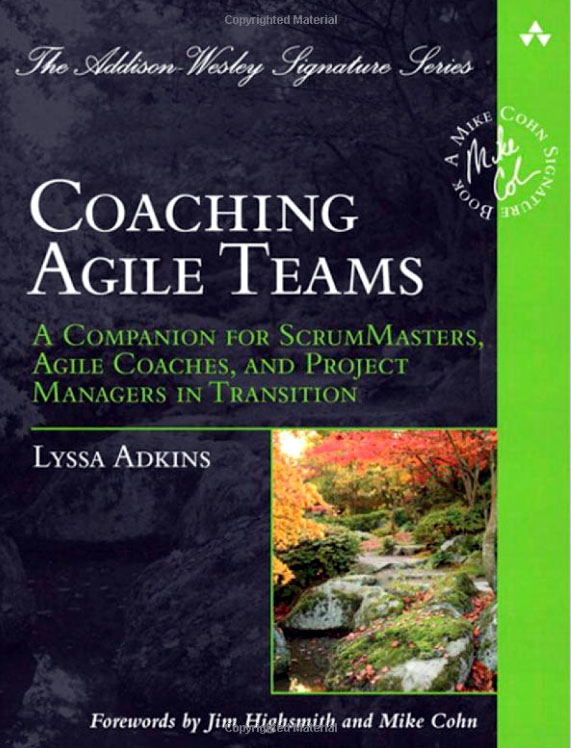 As I continue to work with more and more teams, Lyssa Adkins' Coaching Agile Teams has become a constant companion. Whether I'm searching for a way to reach a particular individual, or seeking to raise the level of the team as whole Lyssa has provided a wealth of practical information to guide the way. No Scrum Master or Agile Project Manager should be without this book.
As I continue to work with more and more teams, Lyssa Adkins' Coaching Agile Teams has become a constant companion. Whether I'm searching for a way to reach a particular individual, or seeking to raise the level of the team as whole Lyssa has provided a wealth of practical information to guide the way. No Scrum Master or Agile Project Manager should be without this book.
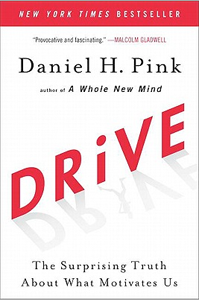 Why do we do the things that we do? It is an important question for those of us interested in helping teams and organizations become more effective at what they do. Daniel Pink writes a fascinating book, Drive, dispelling the notion of carrot-stick motivation models most commonly used in today's business world, and instead urges us to appeal to intrinsic motivations. Citing both scientific studies and real-world research, Pink makes a compelling case for three elements. Autonomy -- the freedom to have some level of control over what work we do and how we do it; Mastery -- the opportunity to become really good at something; and Purpose -- being a part of something bigger than ourselves to which we feel strongly connected.
Why do we do the things that we do? It is an important question for those of us interested in helping teams and organizations become more effective at what they do. Daniel Pink writes a fascinating book, Drive, dispelling the notion of carrot-stick motivation models most commonly used in today's business world, and instead urges us to appeal to intrinsic motivations. Citing both scientific studies and real-world research, Pink makes a compelling case for three elements. Autonomy -- the freedom to have some level of control over what work we do and how we do it; Mastery -- the opportunity to become really good at something; and Purpose -- being a part of something bigger than ourselves to which we feel strongly connected.
A great fit for the agile principle of self-organizing teams, this enlightening view of intrinsic motivation goes a long way toward understanding why some teams and organizations thrive while others merely survive. As an additional bonus, Pink also provides strategies and suggestions for leveraging these motivations to improve both ourselves and our organizations.
You can also watch Dan talk about the book in this short video
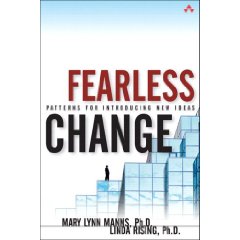 As a developer, analyst, and designer I have seen the rise of patterns that recognize common behaviors and advance learning of the craft. I was therefore curious about this book; Fearless Change, Patterns for Introducing New Ideas by Mary Lynn Manns and Linda Rising. Then after meeting Linda at a recent conference I was hooked and bought the book.
As a developer, analyst, and designer I have seen the rise of patterns that recognize common behaviors and advance learning of the craft. I was therefore curious about this book; Fearless Change, Patterns for Introducing New Ideas by Mary Lynn Manns and Linda Rising. Then after meeting Linda at a recent conference I was hooked and bought the book.
The authors immediately begin talking about a pattern language that focuses on the Change Agent, the Culture and the People of the organization in which change in being introduced. The pattern names themselves allow us to speak and be understood in this language. For instance:
As an Evangelist I want to introduce iterative development by proceeding Step By Step to Test the Waters while taking Time for Reflection and focusing on Small Successes.
Without knowing the particulars of these patterns we still have a good sense of what course we want to take. The actual pattern definitions then speak to the actions and motivations we should consider as we move forward.
This is a very insightful book I would highly recommend to anyone wanting to understand how to successfully introduce and adopt organizational changes.
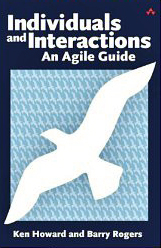 I had the pleasure of hearing Barry Rogers and Ken Howard speak at a recent regional conference and that lead me to read their new book Individuals and Interactions, An Agile Guide. The book is a gem. With so many books focused on the practice side of agility, it is refreshing to see a new book focused on the people side.
I had the pleasure of hearing Barry Rogers and Ken Howard speak at a recent regional conference and that lead me to read their new book Individuals and Interactions, An Agile Guide. The book is a gem. With so many books focused on the practice side of agility, it is refreshing to see a new book focused on the people side.
A recurring theme in the book is the DiSC framework to assess one's primary and secondary behavioral styles in the workplace. I apparently am an "Si", meaning my primary style is Steadiness with secondary style of Influence, and my priorities tend to focus on Enthusiasm, Collaboration, and Support. I found the model intriguing and plan on learning more about it.
Even though the book deals with the messy, touchy-feely people side of agility, Ken and Barry take a very pragmatic approach toward discussing such things as team dynamics, communication, collaboration and team behaviors. Their use of real world examples taken from their considerable experience is very helpful in framing their discussions, and I particularly like their convention of closing comments at the end of each chapter to restate their key points.
Individuals and Interactions is a straightforward, plain language discussion of some very sensitive topics that I think anyone focused on growing agile teams will find to be a great resource.
"Let's try this and see what happens. If it works, do more of it. If it doesn't. change it or do less.
We'd rather fail fast than not test."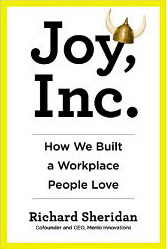
Many organizations think they allow themselves the opportunity to try new things, but in really have too fearful of a culture to let it happen. Not so with Menlo Innovations. In Joy Inc. CEO Richard Sheridan shares a compelling and engaging journey of evolution, innovation and experimentation that brings a vision of a better future into reality. As he advises, the precise model Menlo Innovations has built may not fit your situation, but by following this story of evolution and a steadfast belief in a set of central principles you too can move toward unimagined success.
No agile practitioner should pass this story by.
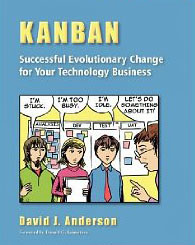 "The management leverage point for improving quality is to reduce the quantity of work-in-progress".
"The management leverage point for improving quality is to reduce the quantity of work-in-progress".
While this is common sense, it is not common practice. Why? Often the inability or unwillingness to set priorities based on business value. We will always have more work requested of us than we can possibly do; we need a credible way of focusing on what is really important. Taking (little k) kanban out of the manufacturing realm, David Anderson has given birth to (big K) Kanban for technology organizations based on his personal experiences of managing the onslaught.
- Focus on Quality
- Reduce Work-in-Progress
- Deliver Often
- Balance Demand Against Throughput
- Prioritize
- Attack Sources of Variability to Improve Predictability
Learn from his in-depth explanation of each of these six steps to start your own evolution.
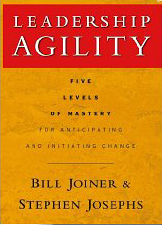 Leadership agility is the ability to lead effectively under conditions of rapid change and mounting complexity. Why it is important is that the pace of change in the world is increasing and the level complexity and interdependence is growing.
Leadership agility is the ability to lead effectively under conditions of rapid change and mounting complexity. Why it is important is that the pace of change in the world is increasing and the level complexity and interdependence is growing.
Bill Joiner & Stephen Josephs Leadership Agility is quickly becoming a seminal resource for growing leadership in today's turbulent business environment. For those of us interested in growing agile organizations, Leadership Agility paints a great framework and vocabulary to help leaders at all levels understand the need to lead both from an intent of control and an intent of influence as the situations before us merit.
Read Bill Joiner's white paper to get a flavor of the framework, then read the book for the full foundation and start your path on becoming an agile leader.
I've recently re-read both of these books and continue to get more insight from them both. Told in a story format, neither is the typical leadership or organizational development foray into the nebula. They speak of real people and real situations to help us understand that solving other people's problems begins with solving our own -- we are part of the problem too.
- Are we looking at others as people with similar needs as our own, or simply as objects that stand in the way of what we want?
- Do we allow our actions and interactions to be colored by the "Better-Than " or "Must-Be-Seen-As" boxes?
- Are our interactions really collusions that make the issues worse, not better?
All of us, and each of our team members, will too frequently find the answer to all of those questions to be a resounding yes! Read these books to learn about getting out of those boxes to lead in ways that respect people and their needs to astounding results.
Also visit the Arbinger Institute for more information and additional resources.
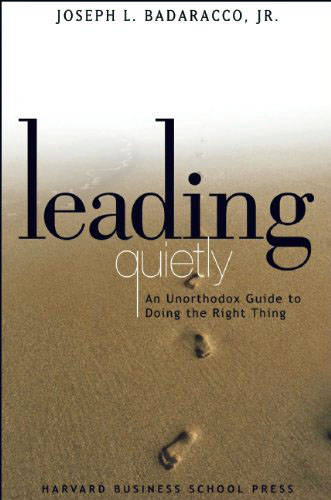 Leading Quietly has been a favorite for a number of years and in many ways was a precursor to some of the more recent thinking in leadership development circles.
Leading Quietly has been a favorite for a number of years and in many ways was a precursor to some of the more recent thinking in leadership development circles.
First one needs to move away from the thinking that was born in Frederick Taylor's industrial age that leadership is all about position and power. Armed with the thought that leadership is more about influencing, molding, and mentoring, Joseph Badaracco shares real world stories of how organizations really work. It is not the larger-than-life figures taking momentous steps that effect change in our organizations. Instead it is the "quiet leader" often working behind the scenes taking incremental steps to improve specific circumstances for themselves, their co-workers, and their organizations regardless of their job title or level of authority.
Quiet leaders focus on doing the right thing even though doing so may go against the rules or conventional thinking. They are the embodiment of Margaret Mead's -- "Never doubt that a small group of thoughtful, committed citizens can change the world; indeed, it's the only thing that ever has." -- and the people around them are the better for it.
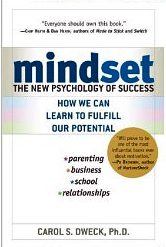 "You did very well on that test, you must be very smart". An innocent enough statement that most of us would believe has a positive influence. In fact, the statement enforces the believe that our characteristics, like intelligence, are finite and instills a sense of urgency that we need to continually re-prove our capabilities. Taken to the next step, we can then become threatened by anything that does not make us seem "smart".
"You did very well on that test, you must be very smart". An innocent enough statement that most of us would believe has a positive influence. In fact, the statement enforces the believe that our characteristics, like intelligence, are finite and instills a sense of urgency that we need to continually re-prove our capabilities. Taken to the next step, we can then become threatened by anything that does not make us seem "smart".
In her book Mindset, psychologist Carol Dweck uses significant research to contrast a fixed mindset versus a growth mindset and how we can influence the latter. Don't let the words psychologist and research in the last sentence throw you. If you are a leader of agile teams, her eminently readable book can be an invaluable source to help you allow your teams to grow and truly exhibit the agile values and principles we espouse.
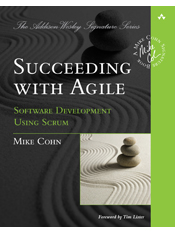 There are three things I admire about Mike Cohn. First, he is a master craftsman of agile software development; second, he is gifted in speaking about, promoting and growing the craft; and third, he does both of these with such grace.
There are three things I admire about Mike Cohn. First, he is a master craftsman of agile software development; second, he is gifted in speaking about, promoting and growing the craft; and third, he does both of these with such grace.
His latest book Succeeding with Agile is a must read for anyone serious about agile software development. Building on his previous books, Mike provides in depth advice for initiating and sustaining agile adoptions. Whether the topic is helping individuals understand how their roles may change; understanding the expectations placed on self-organizing teams and the leadership they require; or how agility permeates the organizational, Mike offers practical know-how based on experience and common sense. His stories and anecdotes of real-world experiences bring home his points, and he provides abundant resources from other industry leaders for additional learning. This is a book I will continue reference at length as I face the challenges he so ably describes.
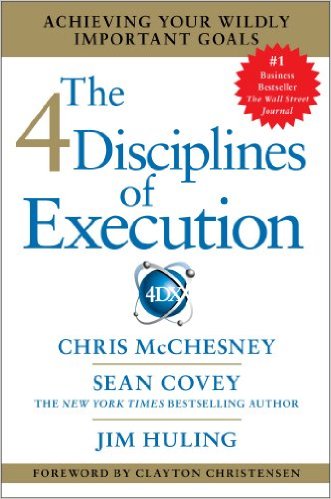 I take special note when I come across sources outside of the agile community that unwittingly promote agile principles and practices. First, it gives further credence to the topic, and second (and more importantly) it puts the topic in a different context and vocabulary that may better resonate with broader audiences. Such a source is The 4 Disciplines of Execution. While authors Chris McChesney, Sean Covey, and Jim Huling would not put their work in the context of agile principles and values, it is pretty easy to make the association.
I take special note when I come across sources outside of the agile community that unwittingly promote agile principles and practices. First, it gives further credence to the topic, and second (and more importantly) it puts the topic in a different context and vocabulary that may better resonate with broader audiences. Such a source is The 4 Disciplines of Execution. While authors Chris McChesney, Sean Covey, and Jim Huling would not put their work in the context of agile principles and values, it is pretty easy to make the association.
- Focus on the Wildly Important
- Act on the Lead Measures
- Keep a Compelling Scoreboard
- Create a Cadence of Accountability
Sound familiar? Take a look at the 12 agile principles defined in the Agile Manifesto, or read through the Scrum Guide and see what associations you can make to these four disciplines. The book is a straightforward, information packed read that can help us all better understand whyagility promotes the principles it does.
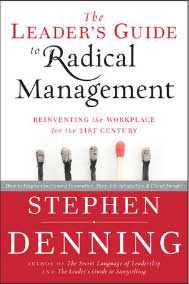 "In today's world of global competition and continuous change, a firm that isn't delighting its clients and turning them into active promoters of its good and services is unlikely to endure". -- Stephen Denning
"In today's world of global competition and continuous change, a firm that isn't delighting its clients and turning them into active promoters of its good and services is unlikely to endure". -- Stephen Denning
Just from that quote, it is pretty clear what author and management consultant Stephen Denning the focus of business should be. In reading his book, The Leader's Guide to Radical Management, you will also discover how much of today's management theories and practices miss the mark by focusing on everything but customer delight.
Denning defines 7 principles of what he terms Radical Management which will be very familiar to agile proponents:
- Focus Work on Delighting the Client
- Do Work Through Self-Organizing Teams
- Do Work in Client-Drive Iterations
- Deliver Value to Client Each Iteration
- Be Totally Open About Impediments to Improvement
- Create a Context for Continuous Self-Improvement by the Team Itself
- Communicate Through Interactive Conversations
His book is an interesting confirmation of agile principles coming not from the technical perspective we are used to, but a purely business point of view.
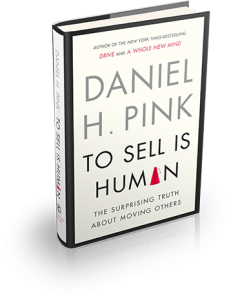 When many us of think of "selling" we conjure up the image of a boisterous extrovert hawking his wares with little or no regard to the actual need his audience may have for them. It is that image that makes it difficult, perhaps painful for some, to understand that regardless of our job title we are all in the business of selling. This is Daniel Pink's key focus in his book To Sell Is Human. Whether it is convincing a prospective employer to hire us, getting our boss to try a new idea, or helping a team mate see a better alternative, today's work environment requires all of us to influence those around us -- to "sell" those around us.
When many us of think of "selling" we conjure up the image of a boisterous extrovert hawking his wares with little or no regard to the actual need his audience may have for them. It is that image that makes it difficult, perhaps painful for some, to understand that regardless of our job title we are all in the business of selling. This is Daniel Pink's key focus in his book To Sell Is Human. Whether it is convincing a prospective employer to hire us, getting our boss to try a new idea, or helping a team mate see a better alternative, today's work environment requires all of us to influence those around us -- to "sell" those around us.
To Sell Is Human is a typically pragmatic view from Daniel Pink of both How We Should Be and What We Should Do in this endeavor. By bringing various perspectives into harmony -- Attunement, persevering in the face of disagreement and rejection -- Bouyancy, and bringing the real problem into a fresh new light -- Clarity, Pink gives us a step by step guide to achieving our own goals by helping others achieve theirs. A must read for any agile leader.
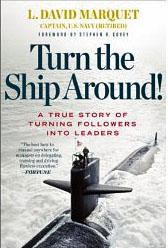 "Captain, I intend to submerge this ship!"
"Captain, I intend to submerge this ship!"
Can you imagine Burt Lancaster saying that to Clark Gable in Run Silent Run Deep? Or perhaps Sam Neill declaring that intention to Sean Connery in The Hunt for Red October? That is not the image of a submarine commander Hollywood has instilled in us, and it is not our perception of how military commands work.
In taking command of a submarine with which he was unfamiliar, David Marquet came to the uncomfortable recognition that leading as what Bill Joiner would call an Expert Leader could endanger the command. Instead he rewrote the book on naval leadership and gave control to his officers and crew, and in the process turned one of the lowest performing crews into one of the best. His account in Turn The Ship Around! is a pragmatic retelling of what he did, what worked, what didn't. From deliberate action to eliminating top-down monitoring systems, Marquet gives us the step-by-step mechanics he used to turn followers into leaders. It is a great guide to use in turning our own ships around.
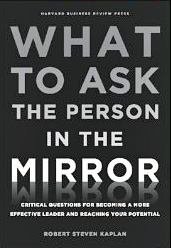 I have been a Robert Kaplan fan for a while and this book is more evidence on why that is. Kaplan has an accessible, down-to-earth way of making his case. In What to Ask the Person in the Mirror, that case is leadership. What should we be doing as leaders? In his view, leadership is not about answering questions. It is about asking questions; asking the right questions.
I have been a Robert Kaplan fan for a while and this book is more evidence on why that is. Kaplan has an accessible, down-to-earth way of making his case. In What to Ask the Person in the Mirror, that case is leadership. What should we be doing as leaders? In his view, leadership is not about answering questions. It is about asking questions; asking the right questions.
"Great leaders are people who stop, reflect, step back and ask questions"
That includes asking questions of ourselves. Have I developed and communicated a clear vision? Is it understood by everyone? Have I set the right priorities? How do I spend my time? Does that align with the priorities?
Interested in being a better leader? Add this book to your reading list, and then read it!

